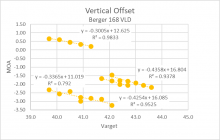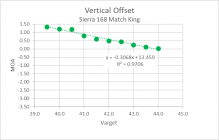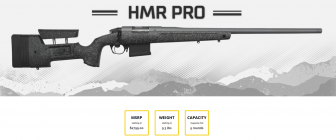Yes, only if it wouldn’t have ruined my brass. Those speeds were too hot!It falls away again from 6 - so loading between 6 and 8 is also an option ?
Install the app
How to install the app on iOS
Follow along with the video below to see how to install our site as a web app on your home screen.
Note: This feature may not be available in some browsers.
You are using an out of date browser. It may not display this or other websites correctly.
You should upgrade or use an alternative browser.
You should upgrade or use an alternative browser.
Point of Impact DROPPING as Velocity Increases?
- Thread starter 222Jim
- Start date
My 100 yard testing has also found that more velocity doesn't always mean higher poi. Im going with muzzle exit timing, but I dunno.
SSL
Gold $$ Contributor
Got my vote. It just so happens I was testing powder charges for my .243 today and kept this thread in mind. Without saying what powder or bullet weight I was using so as to not encourage someone to just jump right in without performing their due diligence, I went from 44.0 to 46.5 grains. and the center of my groups moved downwards (though quite gradually) over the range of my testing. The final load printed just over an inch lower than the first (44.0) load, but in a nearly straight line down (no left-right variance).My 100 yard testing has also found that more velocity doesn't always mean higher poi. Im going with muzzle exit timing, but I dunno.
222Jim
Silver $$ Contributor
Simple reason..............I got lucky first day out and landed on a great load.My more pressing question is why are you doing load development for 100 rounds when your average is already 0.23 moa. Save that load and barrel and go win matches
OP, I think your results actually prove those explanations you read are valid. We have to keep in mind that the closer the target is to the muzzle, the less that all differences in velocity from shot to shot correlate to a change in point of impact. But, gravity’s effect over time of flight is a law, and what you had read are the only explanations, - the faster shots weren’t “aimed” at the same spot.
Looking at the illustration I borrowed from the internet, it is easy to envision certain effects when walking the target back closer and closer to the muzzle; all elevation differences from even wild velocity variances in ammo still converge at an origin point (muzzle), where they overlap completely at the beginning, and deviate slowly but increasingly from there.
Take David C’s result above with 3.5 grains and ~150 fps difference virtually sharing drop between extremes. We must expect and agree that whatever the 100 yard target shows about a 3+ grain lower, slower charge striking similarly, in actuality no one can drop 3 grains of powder and 150 fps and expect the two shots to hit anywhere close together at 1,000; if they did, weighing charges precisely would not matter.
If we take David’s vertical delta between his first and last shot at 100, and multiply it by 10, it still remains an immaterial distance, but JBM puts the slower shot 2.7 moa lower at 1,000, well beyond positive compensation. But he only needed a tiny amount of positive compensation for close range shots to share p.o.i. (He has a lot less than yours, which stands to reason because of the barreled actions’ differences).
At 100, the differences in expected drop between test velocities is small but real. The only possible explanations are harmonics, handling or the environment.
Looking at the illustration I borrowed from the internet, it is easy to envision certain effects when walking the target back closer and closer to the muzzle; all elevation differences from even wild velocity variances in ammo still converge at an origin point (muzzle), where they overlap completely at the beginning, and deviate slowly but increasingly from there.
Take David C’s result above with 3.5 grains and ~150 fps difference virtually sharing drop between extremes. We must expect and agree that whatever the 100 yard target shows about a 3+ grain lower, slower charge striking similarly, in actuality no one can drop 3 grains of powder and 150 fps and expect the two shots to hit anywhere close together at 1,000; if they did, weighing charges precisely would not matter.
If we take David’s vertical delta between his first and last shot at 100, and multiply it by 10, it still remains an immaterial distance, but JBM puts the slower shot 2.7 moa lower at 1,000, well beyond positive compensation. But he only needed a tiny amount of positive compensation for close range shots to share p.o.i. (He has a lot less than yours, which stands to reason because of the barreled actions’ differences).
At 100, the differences in expected drop between test velocities is small but real. The only possible explanations are harmonics, handling or the environment.
Attachments
Last edited:
AlNyhus
Silver $$ Contributor
Most gunlore ignores the fact that barrels move when fired. If they didn't move, any old charges of any old powders would show show the same accuracy on target.
Managing barrel movement is what we're doing when we 'tune'.
Good shootin'
222Jim
Silver $$ Contributor
Just following up for those who may be interested.
I've been collecting more data and, always being happy with finding consistency, I am happy to report that "positive compensation" is evident with both of the bullets I'm using in my .308 (Berger 168 VLD and Sierra 168 Match King). FYI, each "dot" is the average of 10 shots.
Interesting that, based only on Berger 168 VLD, the slope of the "positive compensation" appears to get steeper as powder charge increases (i.e. -0.3005 to -0.3365 to -0.4254 to -0.4358).


I've been collecting more data and, always being happy with finding consistency, I am happy to report that "positive compensation" is evident with both of the bullets I'm using in my .308 (Berger 168 VLD and Sierra 168 Match King). FYI, each "dot" is the average of 10 shots.
Interesting that, based only on Berger 168 VLD, the slope of the "positive compensation" appears to get steeper as powder charge increases (i.e. -0.3005 to -0.3365 to -0.4254 to -0.4358).


Agreed. PC happens across a small velocity range. My guess is that you are seeing the barrel warm up.That is not positive compensation across that extremely wide velocity range, and the overall trend would be upward with a limited flat spot. But I have no idea what it could be.
Expanding a little on @davidjoe's explanation, a 100 yd test effectively eliminates normal charge weight variances in the POI. For most modern centerfire cartridges a 100 fps variation in muzzle velocity will result in about 1 caliber of variance in the POI. For the most part the change in POI is related to the line of sight bullet path imparted by the barrel. This tend to depend on barrel harmonics and barrel time along with the effect of any deviation in the centerline of the bore from the centerline of the barrel which imparts a force in the direction of the offset causing a slight deflection of the barrel.
This is essentially what Dan Newberry determined in developing his OCW method. Once the bullet leaves the muzzle its initial direction is determined by that line of sight and remains unaltered. External ballistics and variations in bullet consistency then impact the variations in precision downrange all of which will increase with increasing range (specifically time of flight).
This is essentially what Dan Newberry determined in developing his OCW method. Once the bullet leaves the muzzle its initial direction is determined by that line of sight and remains unaltered. External ballistics and variations in bullet consistency then impact the variations in precision downrange all of which will increase with increasing range (specifically time of flight).
Leave it to me to disagree.That is not positive compensation across that extremely wide velocity range, and the overall trend would be upward with a limited flat spot. But I have no idea what it could be.
Last edited:
CharlieNC
Gold $$ Contributor
Yes, but not over a 300fps range.Leave it to me to disagree.Think about this for a minute. If the bbl is on the upswing and you progressively increase velocity, the bullet will exit sooner in time. So yes, I think it should do what he's seeing because exit is happening sooner and sooner in the bbl's climb, for lack of a better way of putting it. This is a difference with tuning with powder vs a tuner. Same effect but mirror image kinda thing. Speaking only in regard to harmonics here. Not flatter trajectory due to higher velocity.
RegionRat
Gold $$ Contributor
@222Jim , is this more or less the rifle you are running ?

If the rifle weighs about 11 or 12 pounds with the scope, then I am not at all surprised by the pattern.
The major dynamic mode of rifles in this configuration and weight range come from recoil. The structural harmonics being a much smaller part of the results.
How are you shooting the tests in terms of support? Front and rear bags, bipod with rear bag, etc.?
If we put that rig in a clamped shooting machine, or removed the barreled action and mounted it in a fixture, the test pattern would look completely different.
Even just putting that barreled action into a weighted chassis would change those results. As the share of the movement from over-all recoil is reduced, the share from the barrel harmonics and action flexing would dominate the results.
BTW, it is only because the gun and OP can shoot tight that the pattern in the data comes up out of the noise at all. Cudos to the OP for his tenacity. I have had lots of skilled shooters help when we collected data and only seen a few of them who could run that many shots without fatigue.

If the rifle weighs about 11 or 12 pounds with the scope, then I am not at all surprised by the pattern.
The major dynamic mode of rifles in this configuration and weight range come from recoil. The structural harmonics being a much smaller part of the results.
How are you shooting the tests in terms of support? Front and rear bags, bipod with rear bag, etc.?
If we put that rig in a clamped shooting machine, or removed the barreled action and mounted it in a fixture, the test pattern would look completely different.
Even just putting that barreled action into a weighted chassis would change those results. As the share of the movement from over-all recoil is reduced, the share from the barrel harmonics and action flexing would dominate the results.
BTW, it is only because the gun and OP can shoot tight that the pattern in the data comes up out of the noise at all. Cudos to the OP for his tenacity. I have had lots of skilled shooters help when we collected data and only seen a few of them who could run that many shots without fatigue.
I can't disagree with that. I don't shoot 308 but with br kinda(approximate volume and powders) cases, about 1.8gr of powder is a good generalization of distance between sweet spots at top vs bottom of swing. Yes, there are variables to that, so it's a generalization. I can't make the math work to explain what he's seeing unless it's either something about the rifle/setup or possibly seating sensitivity at those fairly large powder intervals. The sierra vs berger test he did "might" support that theory...very much just theory. Interesting results though. I too would like to see more specs on the rifle setup. But too much thinking for a Sunday. Lol!Yes, but not over a 300fps range.
222Jim
Silver $$ Contributor
That's the rifle, plus I added an APA Little Bastard Gen 2 muzzle break and a Vortex PST 5 - 25 x 50 and a level. The rests are Protector front bag installed on a Sinclair (heavy as a bull elephant) tripod and Protector "rabbit ear" bag. I set the rifle up to be, as best as I can judge, horizontal with respect to my point of aim.@222Jim , is this more or less the rifle you are running ?
View attachment 1698688
If the rifle weighs about 11 or 12 pounds with the scope, then I am not at all surprised by the pattern.
The major dynamic mode of rifles in this configuration and weight range come from recoil. The structural harmonics being a much smaller part of the results.
How are you shooting the tests in terms of support? Front and rear bags, bipod with rear bag, etc.?
If we put that rig in a clamped shooting machine, or removed the barreled action and mounted it in a fixture, the test pattern would look completely different.
Even just putting that barreled action into a weighted chassis would change those results. As the share of the movement from over-all recoil is reduced, the share from the barrel harmonics and action flexing would dominate the results.
BTW, it is only because the gun and OP can shoot tight that the pattern in the data comes up out of the noise at all. Cudos to the OP for his tenacity. I have had lots of skilled shooters help when we collected data and only seen a few of them who could run that many shots without fatigue.
The shots were fired over ~4 months. Mean radius of shots, based on a minimum of 10 shot groups, ranges between 0.20 MOA to 0.30 MOA.
Thanks for feedback/insights with respect to recoil vs. structural/internal harmonics. Some thing I read up on over the winter.
Steve Donlon
Gold $$ Contributor
I would think a free recoil test vs a firm hold and weighted push would have a different outcome. I have seen faster loads shoot higher, for what ever reason.
222Jim
Silver $$ Contributor
With my .222 and .22-250, "faster = higher Point Of Impact". This "Faster = lower POI" stumped me when I first encountered it, but it's consistently doing it with my .308.I would think a free recoil test vs a firm hold and weighted push would have a different outcome. I have seen faster loads shoot higher, for what ever reason.
Meanwhile with .222 and .22-250 I consistently get "Faster = Higher POI".
Northridge
Gold $$ Contributor
This is a common thing I see, “upside down ladder” but it will reveal a bottom as you lean on it and then it will rebound and start climbing page… I’ve witnessed this in 7 pound guns and 60 pounders depending on combo of components…
Shawn Williams
Shawn Williams
222Jim
Silver $$ Contributor
It's not barrel warm up. I alternate between shooting "low to high", then "high to low".Agreed. PC happens across a small velocity range. My guess is that you are seeing the barrel warm up.
Jim
Similar threads
- Replies
- 4
- Views
- 755
- Replies
- 10
- Views
- 2,798
- Replies
- 7
- Views
- 931
Upgrades & Donations
This Forum's expenses are primarily paid by member contributions. You can upgrade your Forum membership in seconds. Gold and Silver members get unlimited FREE classifieds for one year. Gold members can upload custom avatars.

Click Upgrade Membership Button ABOVE to get Gold or Silver Status.
You can also donate any amount, large or small, with the button below. Include your Forum Name in the PayPal Notes field.
To DONATE by CHECK, or make a recurring donation, CLICK HERE to learn how.

Click Upgrade Membership Button ABOVE to get Gold or Silver Status.
You can also donate any amount, large or small, with the button below. Include your Forum Name in the PayPal Notes field.
To DONATE by CHECK, or make a recurring donation, CLICK HERE to learn how.











